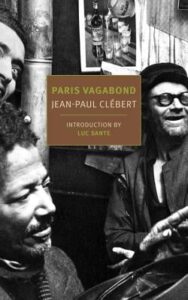
Outsider Paris: A Reading List of the Dark Side of the City of Light
Celia Bell Recommends Mina Loy, Louis-Sébastien Mercier, and More
The City of Light gained its nickname for the streetlights: glass lanterns, a candle inside each one, to illuminate the streets and make them safe to walk even in the depths of night. Three thousand of them were installed in 1667, and every evening the lantern man would pass along his route, unlock the box that controlled the pulley that raised and lowered each lantern, and light the tall candle that would burn throughout the dark hours.
The city levied a new tax just to pay for the cost of candles, and assigned a program of lantern maintenance to each neighborhood. Halfway through the 18th century, the candles slowly began to be replaced with oil lamps. Electric lights did not appear on the streets until 1843.
The streetlights were a modern innovation, and Paris became famous for them. It also began to gain the reputation that it has today, for glittering nightlife, impeccable fashion, and glamor. But there has always been another side to the city’s reputation: while travel guides dwell on the twinkling lights, the thief chased out of the lantern’s circle of illumination has a point of view as well.
My own novel, The Disenchantment, is set in the Paris of the late 17th century, during the Affair of the Poisons—a scandal of poison and black magic that rocked French society, reaching from the back alleys of Paris to the halls of Versailles. Deep social changes were transforming Paris at the time, engineered in part by Louis XIV, who was said to hate the city for the role that its populace had played the Fronde, the rebellion that shook the throne during the king’s youth.
Louis imported swans to beautify the Seine, and they became bedraggled and sick from the Parisian mud, he pushed for the army of lamplighters who would illuminate the city’s dangerous streets after the sun went down, and he oversaw what many call the first modern police force, led by Nicolas de La Reynie—the Lieutenant General of the Police who would also preside over both the investigation of the Affair of the Poisons and the installation of those famous street lamps.
The books below celebrate the darker side of Paris: city of vagabonds and fugitives, mud, chaos, dissidents and revolutionaries, expatriates and ex-convicts, queer men and women, the lonely and the dispossessed. Spanning a period of two hundred years (or a little more) they reveal a vital part of the city that the beautification attempts of Louis XIV and his successors could never quite paint over.
*

Panorama of Paris by Louis-Sébastien Mercier
This eclectic guide to Paris, published just a few years before the Revolution, chronicles the old world on the brink of collapse and the new world about to rise from it. Mercier, born in Paris in 1740, imprisoned for his comparatively moderate politics during the Reign of Terror, and released after the fall of Robespierre, notes down whatever in the city catches his eye—the woman haggling over used undergarments in the markets of Les Halles, the liveried footmen running in front of noble carriages, the man who stands on the street corner and charges a fee to brush down pedestrians’ clothes after the carriages have passed. It’s a chaotic encyclopedia of the city, organized loosely by topic—“Advertisements,” “False Hair,” “Lantern-Men,” “Rent Day.” Originally published in twelve volumes (and cut short not because Mercier ran out of city to describe, but because the Revolution intervened)—Mercier’s Paris is endless.

Paris Vagabond by Jean-Paul Clébert
Written in vignettes on scraps of old newspaper and cigarette packets, not quite a novel or a memoir or a guidebook, Paris Vagabond describes Clébert’s life in clandestine Paris, working the oddest of odd jobs and living on as close to nothing as possible. Clébert ran away from home at seventeen to join the French Resistance, a journey that began when he learned to jump the wall of his middle class boarding school to go sleep rough in the Bois de Boulogne, escaping “the soul-destroying dormitory with its blue ceiling light.” This book of his return to Paris is a hallucinatory chronicle of the disappearing society on the fringes of Paris in the years after the end of World War II. The city that Clébert describes is “Paris from below,” accessible only to the hungry and the down and out.

A Place of Greater Safety by Hilary Mantel
In Hilary Mantel’s first novel, written before Every Day is Mother’s Day but not published until a decade after, Camille Desmoulins, Georges Danton and Maxmilien Robespierre plot Revolution. I love this book so dearly I barely know what to say about it: it’s the kind of book where you can go in knowing exactly who dies at the end, and who betrays who, and how—and if you know a little about French Revolutionary history, you probably will—and still emerge from the last page stunned by the vision that illuminates its pages. Mantel’s revolutionaries feel so alive that one almost feels that the novel might find a way to save them from the course of history.

Astragal by Albertine Sarrazin
We meet Anne, the unruly heroine of Sarrazin’s semi-autobiographical novel Astragal, just as she’s jumping out the window of her prison-like reform school, chasing an ex-girlfriend who’s already been released and breaking her ankle on the way down. Meeting a truck driver by chance on the road outside, she convinces him to take her to Paris: “Just drop me off and I’ll make out alright.”
Escape from prison, however, isn’t so easy—the driver, Julien, turns out to be another ex-convict, and while he’s happy to hide her while her broken bone knits together, it soon becomes another kind of incarceration, as Anne shuffles from a bar owned by a friend of Julien’s where she locks herself in the bath with a bottle of pastis for long hours in search of privacy, to a small apartment she shares with a former sex worker who now makes a living sewing ties, to a hospital ward where she hopes an operation will finally correct the ankle that won’t heal. “Dragging [her] foot like a turtle lugs its shell,” Anne is wounded but not helpless, limping determinedly towards her freedom.

Summer Will Show by Sylvia Townsend Warner
The year is 1848, and the aristocratic Englishwoman Sophia Willoughby has arrived in Paris to retrieve her philandering husband, in the wake of the death of her two children from smallpox—not so much because she actually wants him back, as because he seems to her the only path back to the respectable and contented life that she led before her children’s deaths. Her resolve lasts until the moment she meets her husband’s mistress, Minna, with whom she falls in something very like love at first sight. Minna is an artist and a bohemian, at whose parties revolutionaries and aristocrats uneasily mingle. As she grows closer to Minna, Sophia finds herself becoming a proponent of the revolution, in defiance of the life she once thought she wanted to live.

Insel by Mina Loy
Set in the Surrealist Paris of the 1930s, as the Second World War hangs ominously on the horizon, Insel is a roman à clef about Loy’s friendship with the German experimental painter Richard Oelze, the eponymous Insel. Veering between admiration and disgust, Loy’s heroine, Mrs. Jones, is drawn to the cadaverous and creepy Insel by psychic forces she cannot entirely comprehend.
Becoming his uneasy artistic patron, she offers him money and invites him into her Parisian apartment, but her admiration is undercut by disgust, and she sees him as a kind of mad mascot of an artist, an opportunity for “psychic research” into the lived experience of Surrealism, whose adherents she mocks for failing to practice what they preach. Their uneasy and conflicted relationship plays out against the background of a historical period that threatens to send them both spiraling into madness—or some other, less welcome, fugue state.

Last Words from Montmartre by Qiu Miaojin
This epistolary novel is the last work of Qiu Miaojin. Unpublished at the time of her death by suicide in 1995, is takes the form of letters from Zoe, a young queer woman living in Paris, to her lover, Xu. A love letter, a reflection on art, and a record of life lived under the weight of an immovable depression, Qiu’s novel imbues the quotidian details of life—buying a pet rabbit, making instant noodles—with the profundity of her search for meaning and passion.
__________________________________

The Disenchantment by Celia Bell is available from Pantheon Books, an imprint of the Knopf Doubleday Group, a division of Penguin Random House, LLC.
Celia Bell
Celia Bell has written short fiction for VQR, The White Review, The Sewanee Review, The Southern Review, and Bomb Magazine. She is the winner of the 2018 VQR Emily Clark Balch Prize for Fiction and holds an MFA from the New Writers Project at the University of Texas. Her debut novel, The Disenchantment, came out in 2023.



















